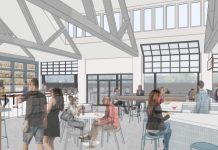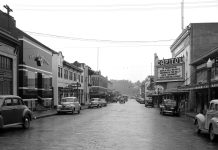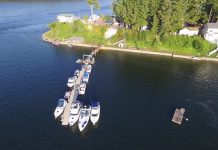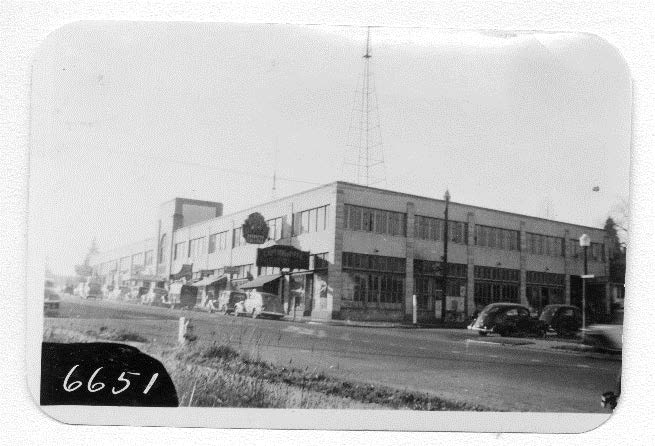
By Emmett O’Connell
 It was the late 1920s when the Capitol Campus’ architecture and landscape first started to take shape. During this same time, Leo and Bud Dawley broke ground for what would become the first commercial building of its kind in Olympia.
It was the late 1920s when the Capitol Campus’ architecture and landscape first started to take shape. During this same time, Leo and Bud Dawley broke ground for what would become the first commercial building of its kind in Olympia.
The Capital Park Building, contemporarily known as the 1063 Building located on the corner of Capitol Way and Union Avenue, was a state of the art facility when it opened in 1930. Described as a “city in itself,” the building was Olympia’s first true shopping center. At this time, the shopping center model was a more than decade-old idea, but the concept had not yet been introduced to Olympia.
The building replaced a series of private homes, marking the neighborhood’s transition from a sleepy residential area to an extension of Olympia’s downtown core. Thurston County’s new courthouse (erected at almost the same time) was an early neighbor of the building. Depsite being made from matching standstone, Capital Park and the courthouse stood in stark contrast to the Capitol Campus. Capital Park and courthouse were designed in modern art deco, while the Capitol Campus featured prominent Greek columns.
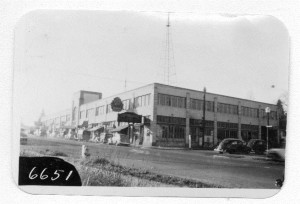
Once construction of the building was complete, tenants started moving in. Some of the first businesses to inhabit the building included an early version of the Olympia Farmers Market (known as a public market back then), KGY radio, a few law offices and even a business college.
Capital Park was also likely the first building in Olympia to feature its own underground parking garage. Holding up to 90 vehicles, the garage allowed customers to drive directly to the building and park and enter the shopping or office areas completely indoors.
Because of its close proximity to the Capitol Campus, it didn’t take long for tenants like the Capitol News Bureau, the Washington State Association of County Commissioners, and the Federation Industries of Washington to set up shop in the building.
However, despite that proximity, public agencies were slower to move in. The first public agencies to inhabit Capital Park waited until 1943 and included only one state and one federal agency. The Department of Labor and Industries took up a spot in 1947, but the overall majority of the tenants were still private.
The most significant change to come to the building in its early years was the opening of Capitol Bowling Lanes in 1943. The bowling alley was a popular gathering place for two decades, until it closed in 1963.
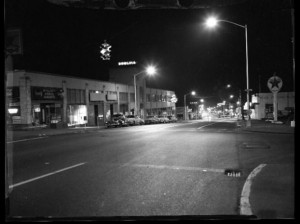
By the 1950s, after the state supreme court ruled that state agencies must again be headquartered in Olympia, the mix of tenants shifted. The balance of retail and commercial occupants went toward either public agencies or private groups that did business with the state.
The state finally bought the building in 1982, further expanding the footprint of state agencies in the building. At various points, agencies like the Office of the Attorney General and the Department of Natural Resources have set up shop at Capital Park.
Three major community institutions that got their start in the Capital Park Building include the Washington State Employees Credit Union, the Hands On Children’s Museum and TVW. Washington State Employees Credit Union’s original offices between 1960 and 1968 were in two different sections of the building. After its Capital Park location, the credit union moved a few blocks down on Union Avenue, where they stayed until recently with the opening of their new building just next door.
While the Hands on Children’s Museum didn’t get its start at Capital Park, it did have some of its most fruitful years there. Moving from a small storefront to the building in 1998, the museum expanded three times during its stay there. Also, during its years at Capital Park, the museum became the largest and most visited (per square foot) children’s museum in the Pacific Northwest.
TVW, often billed as Washington State’s version of C-SPAN, is a non-profit that offers gavel-to-gavel coverage of the state legislature. The station’s original offices were in the Capital Park Building in the mid-90s, where it stayed until 2007 when the station moved into its own building across the street.
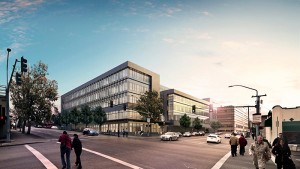
Nearly 100 years ago, Capital Park was a state of the art building and the only of its kind in the city. However, by 2013, the building outlived its usefulness and was slated for replacement by the state. Just last month, the deconstruction of Capital Park — or the 1063 Building as it came to be known — began. Upon its completion, a new, energy efficient, five story building will replace Capital Park and is expected to house at least six different agencies.
To watch the demolition and building progress of the 1063 building, visit the Department of Enterprise Services page for current images, refreshed every 15 minutes, of the ongoing project.
References and further reading





